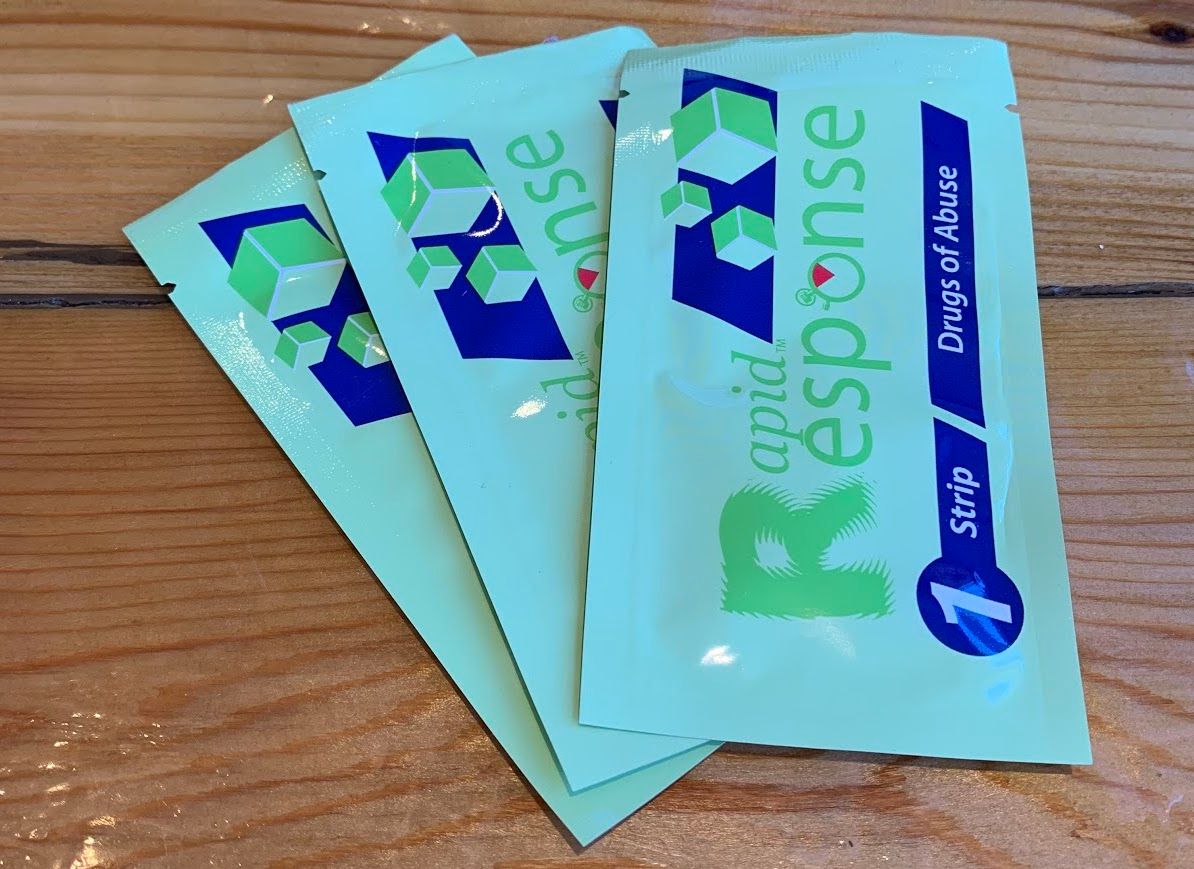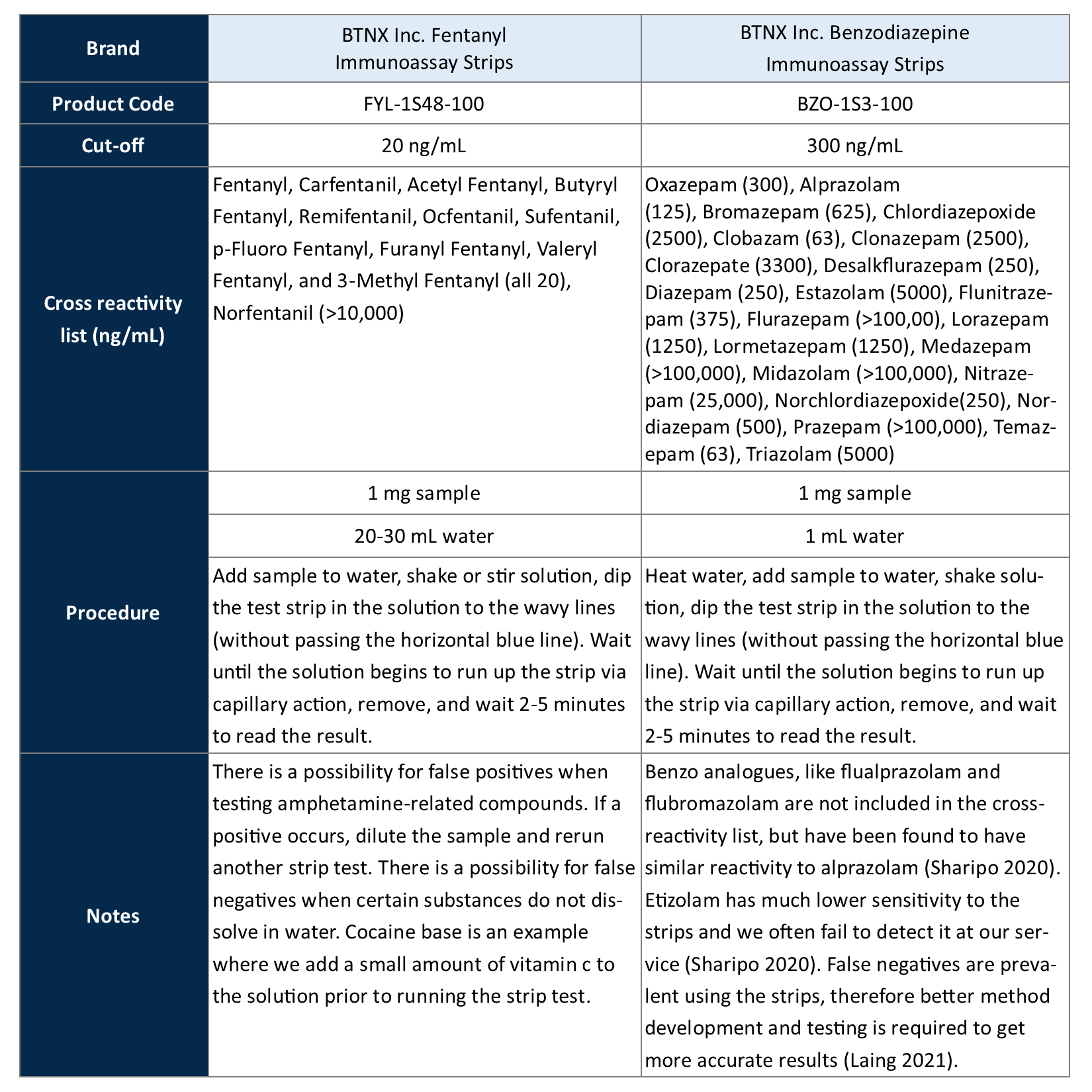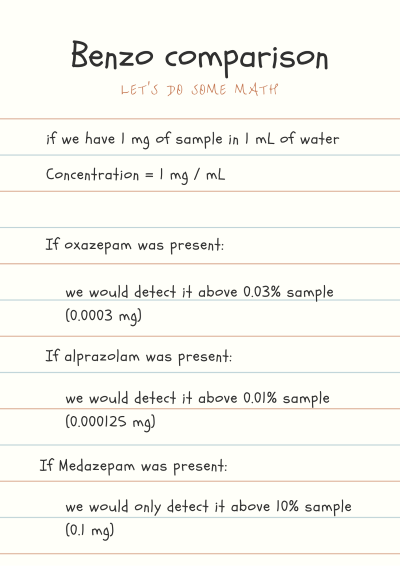Benzodiazepines, Etizolam and the Test Strips

We’ve been receiving a lot of questions lately about the use of benzodiazepine test strips at our service ... and no wonder, our January Report shows that benzodiazepines and related drugs were detected in 50% of opioid down samples last month. Here we will try to answer some of these questions and describe some of the differences between using a test strip for benzos compared to the more common fentanyl test strips.
What are benzodiazepines and where are they coming from?
Benzodiazepines are a large class of drugs used both in medical and recreational contexts. Medically, they treat many conditions ranging from anxiety disorders to epilepsy. Recreationally, they may be used for their sedating and anti-anxiety effects and to ease the come down off of other drugs, like stimulants or psychedelics. The benzo class includes many individual drugs, but only a subset are approved by Health Canada, including lorazepam (Ativan), diazepam (Valium) and alprazolam (Xanax). The most common benzos detected at our service are etizolam, flualprazalom, and alprazolam. Benzos can be diverted from the pharmaceutical market or can be illicitly produced and bought in the community or from the dark web. Learn more about benzos here.
Why are benzos in the opioid-down supply concerning?
Benzodiazepines and related drugs are increasingly showing up in the opioid-down supply both in BC and across Canada. Opioids alone can lead to fatal respiratory depression in an overdose. The combination of benzos with opioids further complicates the overdose response due to the additive sedating effects of benzos. Naloxone, the opioid overdose antidote, is also not active against benzos, though naloxone should still be given in the case of an overdose. The ongoing adulteration of the opioid supply, compounded with the high variability in concentrations, has been concerning for people who use opioids and those who support them. While some folks seek out the additive effects of benzodiazepines and opioids, others are surprised to find benzos in their dope.
What is the difference between detecting benzos and identifying benzos?
In our service, detecting the presence of a benzo means we can tell you whether or not a benzo is present. This detection is separate from identification because it doesn’t specify which benzo is present. Detection is important, but so is identification because each benzo has a different strength and duration of action. We aim to identify specific benzodiazepines so we can give you the most info possible!
How are we currently detecting benzos at our service?
At the point of service, we screen for benzos using BTNX Inc. Benzodiazepine Test Strips. Our other technologies have the potential to detect and identify benzos when they are above our limit of detection, which is about 5% of an overall sample. Our collaboration with Dr. Chris Gill and his team at the Vancouver Island University has allowed us to better identify specific benzos using the paper spray - mass spectrometer, but some method development is required to provide further accuracy in this identification. While we are often able to detect benzos at the point of service using the strips, we cannot always identify the specific benzo present.

How do the benzo test strips work? Are they the same as fentanyl strips?
The benzodiazepine strips work similar to the fentanyl strips in that they screen for a drug of interest. If that drug is present, its molecular structure will react with the bottom line of the strip and cause it to disappear, triggering a positive result. Unlike the fentanyl strips, which only target fentanyl and some of its analogues, the benzo strips are less specific because they target a broad range of drugs within the benzo class. Therefore, the binary test gives a yes or no answer for the detection of a benzo, but provides no identification of which benzo in the diverse class is present and at what concentration.
Here we present a strip by strip comparison highlighting key product information (BTNX Inc., N.D.) and notes from what we have learned so far from our service in Victoria:

Do all benzos react with the benzo strips the same way?
The table lists the benzos that have been validated to cross-react with the benzo strips, but each benzo has a different concentration in which it causes a positive result and not all benzos have been validated. The 300 ng/mL cut-off value is calibrated by oxazepam reactivity. Alprazolam is more sensitive (less benzo is needed to trigger a positive), while medazepam is much less sensitive (more benzo is needed to trigger a positive). When things are less sensitive, we may get false positives if they are below the limit of detection. See the math example below to see values:

Are there limitations to the benzo strips? What about the etizolam I keep hearing about?
A main limitation of the benzo strips is that they don’t detect all the drugs within the diverse benzo class, including benzo analogues that are commonly being found in the drug supply. For example, the most common benzo we find is the analogue etizolam, which has low sensitivity of detection on the strips due to its thienodiazepine structure and means we cannot reliably detect it during service. Etizolam is not used pharmaceutically in Canada, but is a commonly used in other parts of the world. Another limitation of benzo strips is their higher limit of detection relative to their fentanyl counterparts; this means that we need to use more of a sample in order to reliably detect benzos if they are present.
How are the strips useful?
More information is better than no information at all. The strips are still able to signal the presence of a benzo more accurately than our other instruments and we continue to use them at our service. Even without identifying which benzo is present based on the strip result, we can still infer information based on the positive or negative result alone. For example, if we receive a Xanax tablet where the expected benzo is alprazolam and we find a negative strip result, then we can reasonably conclude that no alprazolam is present. This suggests the tablet is not pharmaceutically made and another compound is likely present. While we cannot derive the presence of alprazolam from a positive benzo strip, we can use the context of the results to inform further analysis of the substance.
Conclusions
With certain benzo analogues like etizolam evading our test strips, along with the limitations of our in-service machines to detect low concentration actives, it continues to be a challenge to accurately detect benzodiazepine adulteration in the drug supply at our service. Overall benzo strips have proven to be useful as a screening tool in certain contexts, but they are not a comprehensive screen and are best used in conjunction with additional technologies, like mass spectrometry.
Over the last two years of operating our service, we have documented the ebb and flow of the illicit supply. Novel substances and adulterations continue to ensure an unpredictable supply and continue to enact challenges for people who use drugs. As we discussed in previous posts, the drugs themselves aren’t the issue, their criminality is. For this reason, we continue to operate a drug checking service in the community so that we can provide you with as much information about your substances as possible. Even though we have our limitations, as shown with the benzo test strips, we try our best to provide you with some quality control in an illicit market. We hope that new technologies and developments will make drug checking more useful, but moreso, we hope that policies and regulatory changes are made that will decrease the need for drug checking services in the first place. After all, a stable supply is a safer supply.
More information:
BCCSU Community Resources: https://drugcheckingbc.ca/resources/community-resources/
BCCDC Etizolam Fact Sheet: https://towardtheheart.com/assets/uploads/1609977106OOyN2HFTlkYYKxfbZi8XL6s1NfTlHl0ejSYqQnt.pdf
BCCDC Opioids and Benzos or Etizolam: https://towardtheheart.com/assets/uploads/1609802595WXFJCmRP6tu1qI04J8t6BzVqs7D6e2JA3DiRkVR.pdf
Shapiro, A., Sim, D., Wu, H., Mogg, M., Tobias, S., Patel, P. et al. (July 2020). Detection of etizolam, flualprazolam, and flubromazolam by benzodiazepine-specific lateral flow immunoassay test strips. Retrieved from https://www.bccsu.ca/wp-content/uploads/2020/08/BenzoTestStrip_Report.pdf
Laing, M., Ti, L., Marmel, A., Tobias, S., Shapiro, A., Laing, R., Lysyshyn, M., Socias, M. E. (February 2021). An outbreak of novel psychoactive substance benzodiazepines in the unregulated drug supply: Preliminary results from a community drug checking program using point-of-care and confirmatory methods. International Journal of Drug Policy. Retrieved from: https://doi.org/10.1016/j.drugpo.2021.103169

